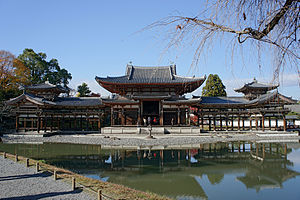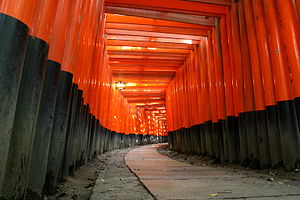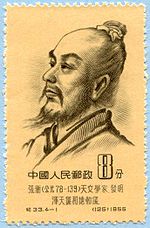
Portal:Asia

Asia is the world's largest and most populous continent, located primarily in the eastern and northern hemispheres. It covers 8.7% of the Earth's total surface area (or 30% of its land area) and with approximately 3.9 billion people, it hosts 60% of the world's current human population. It is traditionally defined as part of the landmass of Africa- Eurasia lying east of the Suez Canal, east of the Ural Mountains, and south of the Caucasus Mountains and the Caspian and Black Seas. The history of Asia can be seen as the collective history of several distinct peripheral coastal regions such as, East Asia, South Asia, and the Middle East linked by the interior mass of the Eurasian steppe.The coastal periphery was the home to some of the world's earliest known civilizations, with each of the three regions developing early civilizations around fertile river valleys. These valleys were fertile because the soil there was rich and could bear lots of root crops. The civilizations in Mesopotamia, the Indus Valley, and China shared many similarities and likely exchanged technologies and ideas such as mathematics and the wheel. Other notions such as that of writing likely developed individually in each area. Cities, states and then empires developed in these lowlands.The steppe region had long been inhabited by mounted nomads, and from the central steppes they could reach all areas of the Asian continent. The northern part of the continent, covering much of Siberia was also inaccessible to the steppe nomads due to the dense forests and the tundra. These areas in Siberia were very sparsely populated.The centre and periphery were kept separate by mountains and deserts. The Caucasus, Himalaya, Karakum Desert, and Gobi Desert formed barriers that the steppe horsemen could only cross with difficulty. While technologically and culturally the city dwellers were more advanced, they could do little militarily to defend against the mounted hordes of the steppe. However, the lowlands did not have enough open grasslands to support a large horsebound force. Thus the nomads who conquered states in the Middle East were soon forced to adapt to the local societies. The culture of Asia is human civilization in Asia. It features different kinds of cultural heritage of many nationalities, societies, and ethnic groups in the region, traditionally called a continent from a Western-centric perspective, of Asia. The region or "continent" is more commonly divided into more natural geographic and cultural subregions, including the Central Asia, East Asia, South Asia (the " Indian subcontinent"), North Asia, West Asia and Southeast Asia. Geographically, Asia is not a distinct continent; culturally, there has been little unity or common history for many of the cultures and peoples of Asia. Asian art, music, and cuisine, as well as literature, are important parts of Asian culture. Eastern philosophy and religion also plays a major role, with Hinduism, Taoism, Confucianism, Buddhism, Christianity and Islam; all playing major roles. One of the most complex parts of Asian culture is the relationship between traditional cultures and the Western world.
edit
Selected panoramaBaalbek is a town in the Beqaa Valley of Lebanon situated east of the Litani River. It is famous for its exquisitely detailed yet monumentally scaled temple ruins of the Roman period, when Baalbek, then known as Heliopolis, was one of the largest sanctuaries in the Empire. edit
Featured pictureA series of torii, the defining feature of Fushimi Inari-taisha, a Shinto shrine dedicated to the spirit Inari in Kyoto, Japan. The thousands of vermilion torii gates are all donations from individuals, families or companies. edit
Featured biography
Zhang Heng was a Chinese astronomer, mathematician, inventor, geographer, cartographer, artist, poet, statesman, and literary scholar from Nanyang, Henan. He lived during the Eastern Han Dynasty (25–220 CE) of China. He was educated in the capital cities of Luoyang and Chang'an, and began his career as a minor civil servant in Nanyang. Eventually, he became Chief Astronomer, Prefect of the Majors for Official Carriages, and then Palace Attendant at the imperial court. His uncompromising stances on certain historical and calendrical issues led to Zhang being considered a controversial figure, which prevented him from becoming an official court historian. His political rivalry with the palace eunuchs during the reign of Emperor Shun (r. 125–144) led to his decision to retire from the central court to serve as an administrator of Hejian, in Hebei. He returned home to Nanyang for a short time, before being recalled to serve in the capital once more in 138. He died there a year later, in 139.Zhang applied his extensive knowledge of mechanics and gears in several of his inventions. He invented the world's first water-powered armillary sphere, to represent astronomical observation; improved the inflow water clock by adding another tank; and invented the world's first seismometer, which discerned the cardinal direction of an earthquake 500 km (310 mi) away. Furthermore, he improved previous Chinese calculations of the formula for pi. In addition to documenting about 2,500 stars in his extensive star catalogue, Zhang also posited theories about the Moon and its relationship to the Sun; specifically, he discussed the Moon's sphericity, its illumination by reflecting sunlight on one side and remaining dark on the other, and the nature of solar and lunar eclipses. His fu (rhapsody) and shi poetry were renowned and commented on by later Chinese writers. Zhang received many posthumous honours for his scholarship and ingenuity, and is considered a polymath by some scholars. Some modern scholars have also compared his work in astronomy to that of Ptolemy (CE 86–161).
edit
Featured article
The Han Dynasty (206 BCE – 220 CE) was the second imperial dynasty of China, preceded by the Qin Dynasty (221–207 BCE) and succeeded by the Three Kingdoms (220–280 CE). It was founded by the rebel leader Liu Bang, known posthumously as Emperor Gaozu of Han. It was briefly interrupted by the Xin Dynasty (9–23 CE) of the former regent Wang Mang. This interregnum separates the Han into two periods: the Western Han (206 BCE – 9 CE) and Eastern Han (25–220 CE). Spanning over four centuries, the period of the Han Dynasty is considered a golden age in Chinese history. To this day, China's majority ethnic group refers to itself as the "Han people" and Chinese characters are referred to as "Han characters". The Han Empire was divided into areas directly controlled by the central government, known as commanderies, and a number of semi-autonomous kingdoms. These kingdoms gradually lost all vestiges of their independence, particularly following the Rebellion of the Seven States. The Xiongnu, a nomadic confederation which dominated the eastern Eurasian Steppe, defeated the Han army in battle in 200 BCE. Following the defeat, a political marriage alliance was negotiated in which the Han became the de facto inferior partner. When, despite the treaty, the Xiongnu continued to raid Han borders, Emperor Wu of Han (r. 141–87 BCE) launched several military campaigns against them. The ultimate Han victory in these wars eventually forced the Xiongnu to accept vassal status as Han tributaries. These campaigns expanded Han sovereignty into the Tarim Basin of Central Asia and helped establish the vast trade network known as the Silk Road, which reached as far as the Mediterranean world. Han forces managed to divide the Xiongnu into two competing nations, the Southern and Northern Xiongnu, and forced the Northern Xiongnu across the Ili River.
edit
Did you know...
edit
In the news Wikinews Asia portal
edit
|






